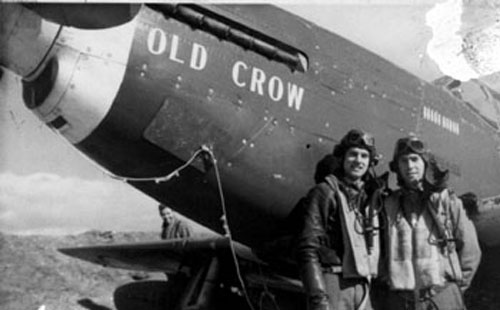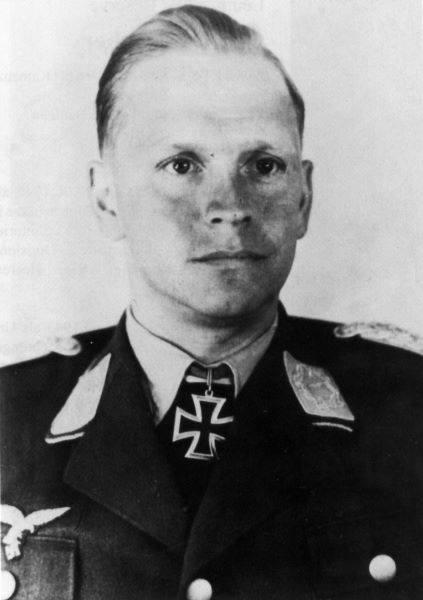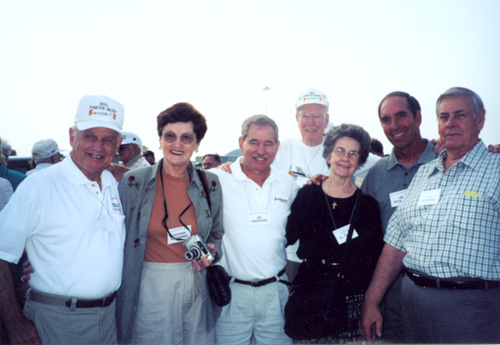
Bud and close friend Jim Browning in front of Old Crow
Captain Jim Browning’s Last Mission – Captain Don Bochkay – 9 February 1945:
” I was flying wing to Captain Browning who was leading CEMENT spares on an escort mission of B-17s to Leipzig, Germany. We were doing nicely on our escort job at 26,000 feet crossing over bombers and holding a very good formation. At 1115 around the Fulda area four ME 262s were called in by one of our flights under us at about 4,000 feet heading toward the bombers. We dropped our tanks and Captain Browning dove to the left for attack. The four 262s broke up, two dove to the right and two to the left. Captain Browning never did get within range of those going left. I climbed high, balls out, keeping the ME 262s in sight as well as covering Captain Browning. I climbed to 28,000 feet and leveled off. Just as I leveled off the two 262s broke right in a steep climbing turn.”
I called Captain Browning and told him I was cutting them off. I dove my ship to gain more airspeed. The sun was in my favor and I believe the 262s did not see me. I came in on the lead 262 and broke hard to the right coming out on the second 262s tail at a very good range of 300 yards. I fired a long burst as he was pulling away from me but I observed some very good hits about the canopy and right engine. That really slowed him down. The lead 262 headed straight down, the one I hit broke to the left in a gentle turn so I opened fire on him again at about 400 yards and kept firing all the way in on him. I saw many strikes all over, his canopy shattered and large pieces were flying off the enemy aircraft. I broke to the right to keep from running into him. As I passed very close to him the pilot was halfway out of his cockpit. The ship then rolled over on its back and the pilot fell out. He never opened his chute and the plane went straight in. I then pulled up in a climbing left to turn to rejoin Captain Browning but we got separated because of some many P-51s in the area with the same colored tails. I found myself alone so I set off to join up with someone from our own bunch.”
Jim Browning did not return from this mission. No one saw what happened to him and his fate was unknown. Due to the tireless work of Merle Olmsted, we present the information he uncovered about the fate of Captain Jim Browning, an American Hero:
Captain James W. Browning, 363rd Fighter Squadron, was one of the gung-ho types, who had come back to the group for a 2nd combat tour. An ace with 5 victories before he departed to the ZI (Zone of the Interior, ie USA) in mid-year, he returned near the end of 1944, and scored two more victories.
The mission on 9 February 1945, was the usual heavy bomber escort, the 357th providing 62 Mustangs in two groups, lead by Colonel Dregne, and Major Peterson. Luftwaffe opposition was in the form of the formidable ME 262 jets, one group of 3, which used their superior speed to evade Greenhouse Squadron.
15 minutes prior to that, at 1140 hours, Cement Squadron, (363rd) engaged 9 ME 262s. From the mission report: “The squadron dropped tanks and dived on the jets which broke into elements of two and scattered. The lead jet, although under attack, turned into the bomber formation and made an attack through the box, one of our elements in pursuit. The remainder were driven away from the bombers with above results.” (This refers to ME 262s destroyed by Bochkay and Carter, and a probable by Foy.) The mission report also states: “One NYR (Not Yet Returned), Captain Browning, last seen vicinity of Fulda.”
Captain Bochkay was flying Jim Browning’s wing that day, both however, were spares and were not required to accompany the mission. Both being eager fighter pilots, pressed on regardless. Bochkay’s later statement: “At 1145 hrs., Capt. Browning was on the tail of two ME 262s and was chasing them. I was covering Capt. Browning at the time and continued to cover him until it was in our favor for me to be the attacker. I then called Capt. Browning and told him that I was cutting him off and for him to cover me. As I was making the attack on the last ME 262, Capt. Browning called me and told me to keep going as he had me covered. That was the last I heard or saw of Capt Browning. This happened at 24,000 feet over Fulda, Germany. There were a large number of P-51s in the area at the time.” So there the matter rested, there was no further information forthcoming on Browning – he had simply disappeared.
There are German documents attached to Browning’s Missing Aircrew Report in the National Archives, but they merely indicate: “1140 hours, one Mustang shot down 3 km SW Wueger, 20 km SW Limburg after fighting with German day fighters. Pilot Capt. James William Browning, s/n 0-740361 and aircraft totally burned.”
The army’s effort to identify and recover the remains of it’s dead were very thorough and painstaking. Investigating teams had fanned out throughout Europe even before the end of the war. German police and town officials were interviewed and many statements of eye witnesses taken. After complete analysis, a board then decided if the remains were recoverable, and if so, they were moved to one of several military cemeteries, and then to the ZI if next of kin desired it. The investigation in this case, did solve the mystery of what happened to Jim Browning.
In a statement dated 5 August, 1947, one Adolf Keller, Burgermeister of the town of Woersdorf says: “On 9 Feb, 1945, at noontime, I saw a dogfight in the vicinity of Wuerges, besides a German fighter which was engaged in the fight, there were several other planes in the air. The German fighter rammed an airplane and both of them caught fire and crashed down.” Keller goes on to say a German Sergeant in charge of Russian prisoners later brought him several items from the wreck which included a gold ring, and ID tag with Browning’s name, a photo with his name on it and some currency. That afternoon, Keller went to the wreck site, and saw the remains of both aircraft. “The body of the German pilot, Freiherr Von Riedesel, Oberstleutanant (LTCOL), was evacuated already.”
The following comments are extracted from a statement dated 6 August, 1947, by one Wilhelm Manrer: “I am a railway employee. On 9 Feb, 1945, I was in my office when I heard firing from weapons of a plane, followed by and explosion. I went outside and saw a cloud of smoke about 600 meters from the station. When I was relieved at 1800 hours, I went to the place of the crash. There I saw the wreckage of a plane scattered over an area of 400 meters. I could not recognize the planes type. On one part I found printed the letters ‘ZANKE’. The plane was burnt. I did not see any remains or parts of a body. Approximately 600 meters from the place of the crash, a German plane had crashed. I however, did not see that crash.”
The ZANKE reported was undoubtedly the canopy rim and the name was “ZARNKE”, since Browning was flying Glen Zarnke’s P-51 JUNIOR MISS on that date. At some point then, after Bochkay had taken the lead on the attack, Browning had collided with one of the jets, both pilots dying as described.
Of interest is the high rank and title of the German pilot. (Freiherr means Baron). My contacts in Germany and the U.S. have identified Riedesel as the commander of KG(J) 54, flying ME 262 Werk Nr (serial number) 500042. This unit was a former bomber Gruppe (same as our wing), as shown the KG designation, which had been re-equipped as a fighter unit (J) at a time when the Luftwaffe needed fighters much more than bombers. KG(J) 54 lost five ME262s this date to the 78th and 357th Fighter Groups.

Freiherr Von Riedesel (Photo from Doug Banks)
Jim Browning new the risks of returning for a 2nd combat tour, when he could have remained in the states, but he came back to “the old outfit” (as many soldiers have a way of doing). The odds caught up with him however, and now after more than 50 years we know what happened to him.
In May, 1949, Headquarters, American Graves Registration Command, Europe, issued a synopsis of his case , and recommended that his remains be declared non-recoverable, one of 26 in the European area as of that date.
Because there were no recoverable remains, James Browning’s name is listed on “The Wall of the Missing” at American Military Cemetery in Luxembourg.
Merle Olmsted, March 1995

Bud, Sandra Browning, Jim Anderson, Lois McPhail (Jim Browning’s sister), Jim Browning (Nephew) and Don Browning (Brother), meet at the last 357th FG Reunion in Dayton, Ohio, September 2001.

